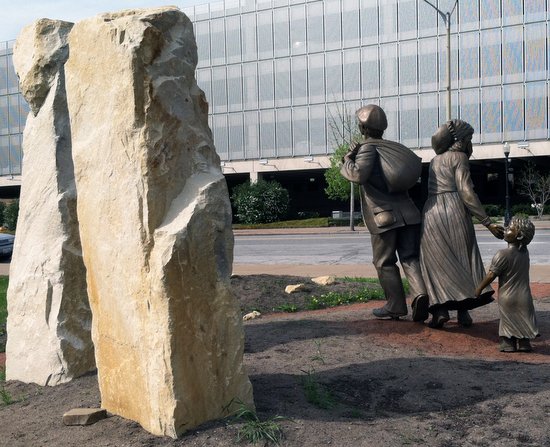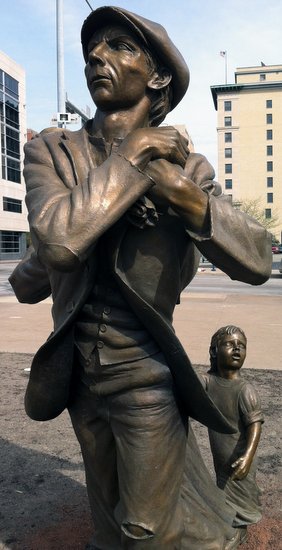
The Charles J. Wright Transit Center at 300 West River Drive in downtown Davenport has two very different works of art related to travel. One is a sculpture of an impoverished Irish family traveling by foot. It is traditionally figurative and meant to draw you in emotionally. The other - modern and emotionally cool - evokes a sense of speed on a highway.
 The Irish memorial is located on the center's north lawn, near the corner of Second and Harrison streets. It's a life-sized bronze statue of a family forced by famine and political oppression to leave Ireland. This story played out many times, as a quarter of Ireland's population either died of starvation or emigrated between 1845 and 1852. Before the end of 1850s, more than 2,000 Irish immigrants lived in Davenport.
The Irish memorial is located on the center's north lawn, near the corner of Second and Harrison streets. It's a life-sized bronze statue of a family forced by famine and political oppression to leave Ireland. This story played out many times, as a quarter of Ireland's population either died of starvation or emigrated between 1845 and 1852. Before the end of 1850s, more than 2,000 Irish immigrants lived in Davenport.
Created in 2011 by Moline native Lou Quaintance, the sculpture depicts a young man with his possessions in a sack on his shoulder, followed by a young woman and a small child. Each conveys a different emotion. The man's face and body language are resolutely directed forward. The woman holds a hand to her face as if overcome with grief. The child looks back with a tear running down its face. A deep sense of past - and future - hardship is conveyed. Behind them are two large stone blocks from Donegal, Ireland. The four-ton stones, reminiscent of the standing stones from ancient Ireland, symbolize the homeland, family, and friends left behind.
Placed on a busy corner and surrounded by contemporary buildings, the sculpture's figures are out of place -which makes the artwork even more meaningful; only two full lifetimes separate such immigrant Irish families from their descendants who live in such a relatively prosperous city.
While the Irish memorial contrasts with its environment, the other artwork at the center reflects its fast-paced setting. Neons for the Transit Center is a flowing arrangement of neon lights across the ceiling of the bus station's lobby. It was created by Stephen Antonakos in 1985, 25 years after he first began working with neon as an artistic medium. Public neon sculptures by Antonakos can also be found in New York; Chicago; Seattle; Tacoma, Washington; Denver; Amherst, Massachusetts; and Atlanta.

The curved and angular forms of the neon tubes mirror the lobby's modern design and semicircular shape. Perhaps because of its setting, the geometric lines feel like routes drawn with vivid color on an expansive highway map stretching across the ceiling. The luminous reddish-orange light is also reminiscent of the passing streaks of taillights on a highway at night.
The transit center's location on River Drive isn't especially relevant - unless we are inspired by the artworks' connection with travel over both time and distance. River Drive is also U.S. Route 61, one of most culturally significant roads in America. Stretching from northern Minnesota to downtown New Orleans, Route 61 is designated as the Great River Road for much of its 1,400-mile length; it is also known as the Blues Highway. The legendary Robert Johnson was said to have sold his soul to the devil at a crossroads, and one of the roads was Route 61. Bob Dylan's "Highway 61 Revisited" is just one of the many songs about the highway. The route was also one of the main roads taken by African Americans to escape Jim Crow laws and seek employment opportunities in the northern industrial cities.
It is easy to lose sight of our connections with distant places and events. Artworks such as the Irish memorial and Neons are aesthetically successful and create a mood that interacts -whether in contrast or harmony - with their surroundings. However, it is their capacity to inspire us to see a wider world - even putting us in the shoes of others - that makes them most meaningful.
Bruce Walters is a professor of art at Western Illinois University.
This is part of an occasional series on the history of public art in the Quad Cities. If there's a piece of public art that you'd like to learn more about, e-mail the location and a brief description to BD-Walters@wiu.edu.










